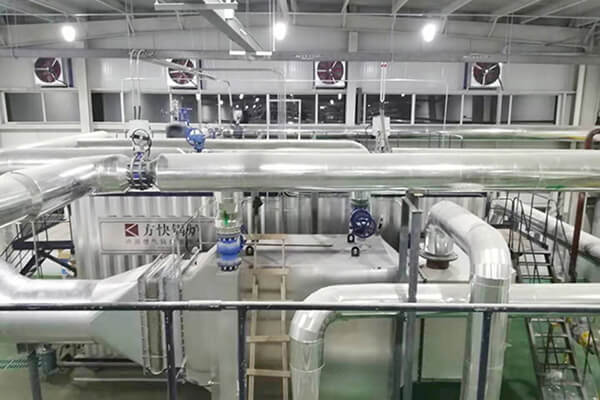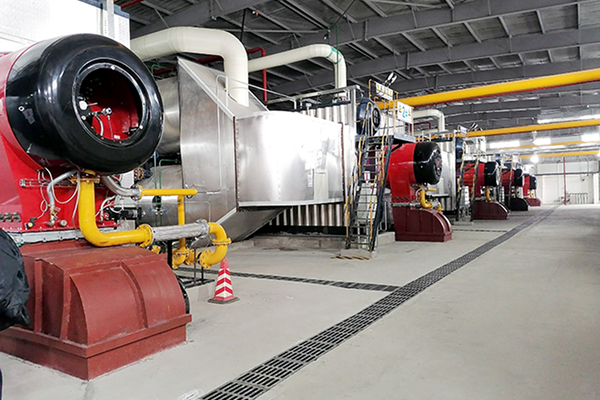The key functions of a steam boiler drum are steam-water separation, water storage, circulation, chemical control and pressure management.It is very important in the entire steam boiler system.
(燃油气过热蒸汽)-1-e1749437718210.jpg)
Primary Functions
-
Steam–Water Separation
One of the drum’s most important roles is to separate the water–steam mixture delivered from the boiler’s water‐cooled walls and riser tubes. Inside the drum are various separation devices—baffles, cyclone separators, louver separators, etc.—that use gravity, inertia and centrifugal force to cleanly separate steam from water. -
Saturated Steam Outlet
The relatively dry saturated steam rises out of the drum’s top outlet and either goes on to the superheater (to become superheated steam) or, in the case of a saturated‐steam boiler, is delivered directly to the process. -
Water Collection
The separated water falls to the lower portion of the drum, where it mixes with feedwater from the economizer, forming the boiler’s water inventory. -
Storage of Boiler Water Volume
The lower half of the drum holds a reserve of water. This volume is essential for safe and stable operation:-
Buffering Fluctuations: During load swings it helps keep water level steady.
-
Maintaining Circulation: For natural‐circulation boilers, its hydrostatic head drives flow; in forced‐circulation boilers, pumps rely on this reserve.
-
Short‐Term Feedwater Loss: If feedwater supply is interrupted briefly, the stored water keeps the boiler running until supply is restored.
-
-
Circulation Loop Connection
-
Inlet: Receives water–steam mixture from riser tubes (water‐cooled walls, convective bundles).
-
Outlet: Routes separated water via downcomers back to the lower header, completing the circulation loop (driven by density difference in natural circulation, or by pumps in forced circulation).
-
-
Chemical Treatment
A dosing device (e.g. phosphate feeder) is mounted on the drum to inject chemicals into the boiler water, preventing scale and corrosion and preserving water quality. -
Continuous Blowdown
A continuous‐blowdown line—usually located near the normal water‐level—is fitted to remove high‐salinity water and control dissolved solids, safeguarding steam purity and boiler integrity. -
Sediment Collection
Particulates and reaction by‐products settle in the bottom of the drum water space and are removed periodically via blowdown. -
Pressure Control Point
The drum is one of the boiler’s highest‐pressure zones (equal to working pressure). Safety valves, pressure gauges and other safety fittings are mounted directly on the drum or its nozzles to monitor and control pressure.
Design & Structure
-
Cylindrical Shell: Rolled from thick steel plate with welded longitudinal seams, capped by ellipsoidal or hemispherical heads—ideal for withstanding high internal pressure.
-
Large Diameter: Provides ample separation volume and water capacity; much larger than the connecting pipes.
-
Multiple Nozzles & Openings: For connections to risers, downcomers, feedwater inlet, steam outlet, chemical feed, continuous and intermittent blowdown, water‐level gauges, pressure gauges, safety valves and manholes.
-
Internal Components: Complex separators (cyclones, baffle plates, louvers), feed distribution piping, chemical feed lines, blowdown orifices, under‐water perforated plates—each precisely engineered to optimize steam quality and separation efficiency.
-
Supports: Mounted on the boiler frame by sliding bearings or guide supports to accommodate thermal expansion.
Multiple large water tube steam boilers
Importance
-
Safety Critical: As one of the highest‐temperature and highest‐pressure parts, drum integrity is vital. Failure can lead to catastrophic explosion.
-
Operation Hub: Acts as the nexus for water circulation, steam separation, chemistry control and pressure regulation—directly impacting efficiency, steam quality and stability.
-
Life‐Cycle Key: Subjected to constant thermal and pressure stresses plus water‐chemistry effects, the drum often governs overall boiler longevity. Regular inspections (wall‐thickness measurements, weld examinations, etc.) are essential.
Conclusion
The steam drum is far more than just a container. It is the core hub of boiler operation, executing critical functions—steam–water separation, water storage, circulation connection, water‐quality management and pressure control. Its design, manufacture, installation and maintenance directly determine the boiler’s safety, efficiency and reliability. As the most important and complex pressure component in the boiler system, the steam drum demands meticulous attention at every stage.
If you want to know more about steam boilers, you can contact us via WhatsApp + 86 182 6995 7295


